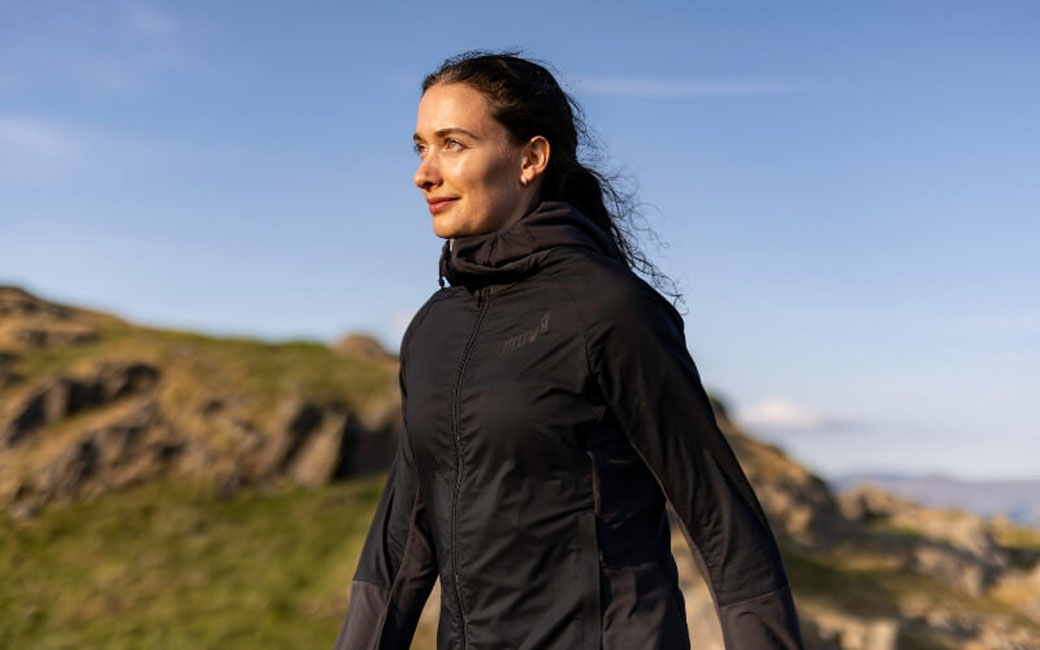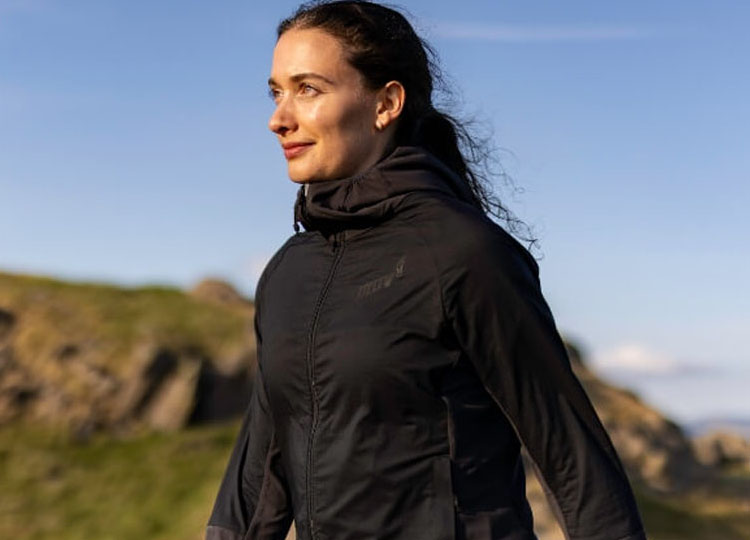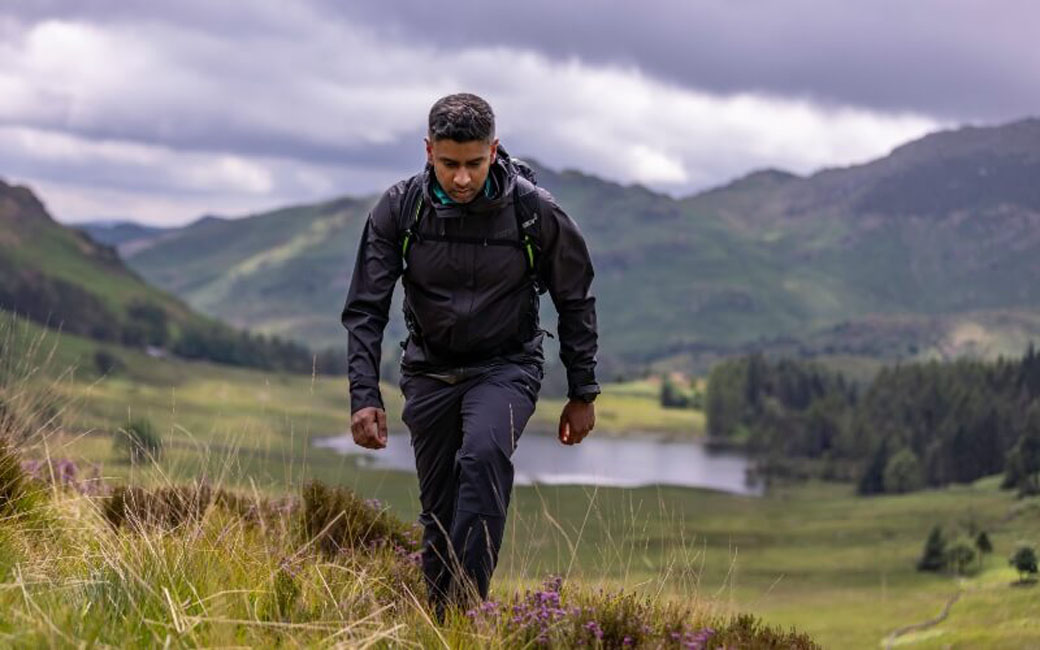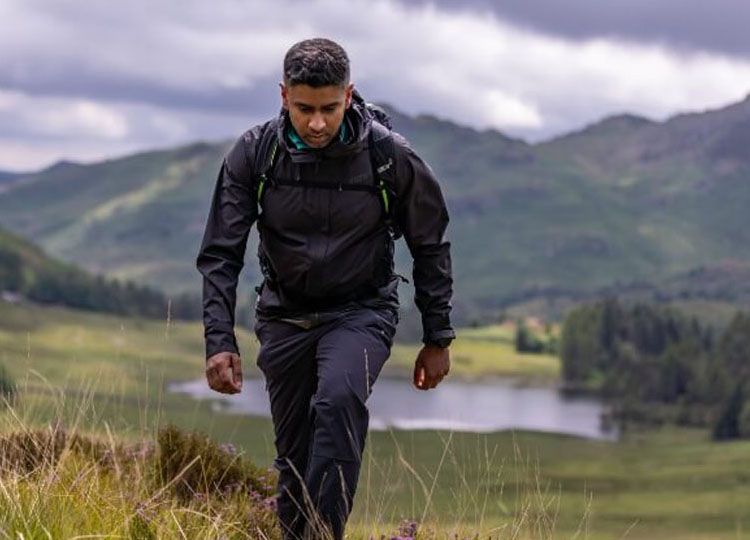
From fast-wicking base-layers and insulating mid layers to waterproof hard shell outer layers, here’s everything you need to know about using our hiking clothing to create the perfect layering system.
Layers on, layers off, layers back on again, oh no wait a minute, layers off again. Hiking in the ever-changeable weather conditions of the UK’s mountains can all seem rather awkward and time-consuming. But, truth be told, there is some sound logic behind these constant wardrobe changes. Here INOV8 ambassador and prolific hiker James Forrest shares the full lowdown on the so-called layering system.
WHAT IS THE LAYERING SYSTEM?
Conventional mountain wisdom has it that several layers are better than a single, thick, bulky one. This is known as the layering system. It enables you to better adapt to changing circumstances and conditions, and to respond to the environment around you. Layers can be removed or added according to the weather or intensity of activity: if it gets cold, simply pull on an insulated mid-layer; if it starts chucking it down, reach for your waterproof jacket; or if the ascent steepens dramatically, strip off down to your base layers.
Conversely if you hike with fewer layers, you have less versatility with your clothing, and you may end up too hot, too cold, excessively clammy, woefully unprotected against inclement weather, or some other unsatisfactory situation. The real selling point of the layering system, therefore, is flexibility - you can make small, regular micro-adjustments to your clothing to suit your body’s needs. Everyone’s body reacts differently in the mountains. You might run hot and sweat profusely, someone else might feel the cold badly. Either way, the layering system can be adapted to work for you.
The most common layering system consists of three layers:
- Base layer - for moisture management and sweat wicking
- Mid layer - an insulating mid layer is for warmth
- Outer layer - to keep the wind and rain at bay
Each layer has a very different function, but together they should work in harmony. There are some challenges with this approach, particularly with breathability and moisture management. But, ultimately, the three-layer system is a trusted approach that works.
It’s also worth noting that the layering system commonly refers to clothing for your upper body. Most hikers will only wear two layers on their legs - underwear and either shorts or hiking trousers - whereas the upper body, which includes your core and vital organs, requires a more complex and intricate clothing system.
Here’s how to plan the perfect layering system with INOV8 hiking clothing.
BASE LAYER
Product choice: INOV8 Merino Long Sleeve Hiking T-Shirt, £85
As the name suggests, base layers are the first layer you put on, worn directly against the skin. They should have a snug, comfy fit, without being too tight. The primary role of a base layer is to regulate your body temperature and wick away sweat from your body.
A high quality base layer will be lightweight, technical and fast-wicking, adding a touch of warmth when required while also effectively moving sweat to the outside of your body. It goes without saying that a cheap cotton t-shirt won’t cut it as a base layer for the mountains. Instead you have two choices in terms of fabric material: merino or synthetic polyester.
Merino wool base layers are warmer than synthetic ones. They are also odour-resistant, fast-wicking and more comfortable when wet, but generally more expensive. Synthetic base layers are better value, with faster wicking and drying, but inferior warmth. Some hillwalkers may find merino itchy and prefer synthetic yarns; others will find merino the perfect fabric. It’s often all down to personal preference.
New for 2024, INOV8 has just released a merino base layer, in both a short sleeve (£75) and long sleeve option (£85). Each product is available in two colourways (black and navy), multiple size options (XS-XXL) and both men’s and women’s versions. Billed as the “ultimate hiking base layer”, this product is made from 100%, ethically-sourced merino. It adds warmth by trapping air in its fibres, but simultaneously keeps you comfortable by wicking sweat quickly and efficiently. The fit is relaxed and comfortable. Or, in other words, the INOV8 Merino Long Sleeve Hiking T-Shirt ticks all of the boxes when it comes to a base layer.
Anyone who doesn’t like merino can opt instead for the INOV8 Base Elite Long Sleeve Base Layer 3.0 (£40), which is made from 100% recycled polyester. This top is not as warm as the merino base layers, but has a lot of the qualities needed in a base layer. It is lightweight, breathable, quick-drying and fast-wicking. A short sleeve version (£35) is also available.


MID LAYER
Product choice: INOV8 VentureLite Mid Hoodie Full Zip - £85
The clue is the name. A mid layer is the middle layer of the three-layer system, commonly worn over a base layer but underneath a waterproof outer layer. It is sometimes referred to as the insulating layer, because its primary role is to retain the body heat you generate and keep you warm. This generally works by trapping warm air in thousands of tiny air pockets. But mid layers also need to balance warmth with breathability and moisture management. A good mid layer will work in conjunction with your base layer to wick sweat away from your body and provide ventilation when required, so that you don’t overheat.
For many hikers, tops and hoodies made from fleece are the most effective and best-performing mid layers. An excellent choice is the INOV8 VentureLite Mid Hoodie. For me, this mid layer hits a sweet spot between warmth, comfort and breathability. I love the hood, the wrist cuff thumb loops, slightly fleecy inner and the lightweight, athletic cut. It adds a touch of warmth when you need it, without being overly bulky or restrictive. It works well underneath a hard shell waterproof or an insulated jacket, but equally can be thrown on as a standalone layer in the spring and summer just to take off the chill. You also get two hand-warmer pockets and a full-length zipper. The inner of the hoodie features a textured, hexagon-shaped grid of fleecy insulation which has been designed to trap air for warmth but also deliver good wicking properties. The VentureLite Mid Hoodie has good eco credentials too – it is made from 92% recycled polyester, combined with 8% elastane for good stretch and freedom of movement. A half-zip version (without a hood) is also available for £75.
Another impressive - but more expensive - option from INOV8 is the Performance Hybrid Jacket. This high-tech jacket is soft and cosy, with excellent warmth, good breathability, faultless comfort, and a clever design using cutting-edge materials. It has a soft shell-like design, combining a weather-resistant Pertex Quantum Air shell with internal insulation. This insulation is PrimaLoft Active Evolve (58% recycled polyester, 42% polyester) – a highly-permeable, mesh-like fabric with rows of fleecy tufts. The body-mapped design places the insulation around the chest, stomach, head, neck, shoulders, upper arms and back (exactly where you need it), while stretchy panels bring comfort, manoeuvrability and flex to other parts of the jackets. Both the VentureLite Mid Hoodie and Performance Hybrid Jacket are excellent mid layers, ticking all of the boxes.
It is also worth noting that on very cold, wintry days some hikers choose to wear another insulating layer - a fourth layer to the system, if you like. This will often be a down or synthetic jacket worn over a lighter, thinner mid layer. This fourth layer - usually a baffled-style jacket with thick, plush insulation - adds loads of cosy warmth, but it will obviously be very easy to overheat in. As such, they are perhaps better suited to times when you’re still – in camp or at a summit – rather than when you’re working hard and require better breathability. A good option from INOV8 is Thermoshell Pro Insulated Jacket 4.0.


OUTER LAYER
Product choice: INOV8 VentureLite Jacket - £200
The final, outer layer of the three-layer system is a waterproof and windproof layer designed to protect you from the effects of rain and wind. Most commonly this in the form of a hard shell waterproof jacket, often utilising a waterproof Gore-Tex membrane or a brand’s in-house waterproofing technology. The sole purpose of such a layer is to keep you dry and protected from the wind.
A good waterproof jacket will have a high hydrostatic head rating (a technical measurement of waterproofing) of 20,000mm or higher. To prevent condensation and a clammy interior, a waterproof jacket also needs to be breathable. Jackets with a 20,000g/m²/24hr breathability rating or higher – a measure of how quickly moisture is wicked away from the body and released through the fabric – will offer the best breathability available. But take these figures with a pinch of salt, because it’s annoyingly easy to over-heat in a hard shell.
INOV8 has a good range of waterproof jackets, all with impressive headline stats. The beefiest, most protective option is the VentureLite Jacket (£200), a premium three-layer waterproof hardshell which has a 15,000mm HH rating and a super-high 40,000g/m²/24hr breathability rating. A cheaper and slightly lighter option is the TrailShell Jacket (£135), which is made from Pertex Resolve and has a 20,000m HH grade. If you want a super-lightweight, minimalist waterproof that’s suitable for running and hiking, the Stormshell V2 Waterproof (£160) is a wise choice.
